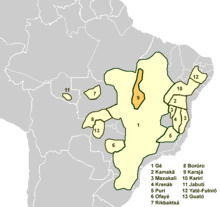Karajá language
| Karajá | |
|---|---|
| Native to | Brazil |
| Region | Araguaia River |
| Ethnicity | 3,600 Karajá people (2007)[1] |
Native speakers | 2,700 (2006)[1] |
|
Macro-Gê
| |
| Dialects |
|
| Language codes | |
| ISO 639-3 |
kpj |
| Glottolog |
kara1500[2] |
 | |
Karajá, also known as Ynã, is spoken by the Karajá people in some thirty villages in central Brazil. Dialects are North Karaja, South Karaja, Xambioá, and Javaé. There are distinct male and female forms of speech; one of the principal differences is that men drop the sound /k/, which is pronounced by women.
Karaja is a verb-final language,[3] with simple noun and more complex verbal morphology that includes noun incorporation. Verbs inflect for direction as well as person, mood, object, and voice.
Phonology
Karajá has nine oral vowels, /i e ɛ, ɨ ə a, u o ɔ/, and two nasal vowels, /ə̃ õ/. /a/ is nasalized word initially and when preceded by /h/ or a voiced stop: /aθi/ → [ãθi] 'grass', /ɔha/ → [ɔhã] 'armadillo'; this in turn nasalizes a preceding /b/ or /d/: /bahadu/ → [mãhãdu] 'group', /dadi/ → [nãdi] 'my mother'.[4]
| Front | Central | Back | |
|---|---|---|---|
| Close | i | ɨ | u |
| Mid | e, ɛ | ə, ə̃ | o, õ |
| Open | a | ɔ |
This language has vowel harmony that matches vowels' tenseness to the vowel of the following suffix.[5]
V → [+ATR] / _ (C)-V[+ATR]
There are only twelve consonants, eight of which are coronal:[6]
| Labial | Dental | Postalveolar | Velar | Glottal | ||
|---|---|---|---|---|---|---|
| Stop/Affricate | Voiceless | tʃ | k | |||
| Voiced | b | d | dʒ | |||
| Implosive | ɗ | |||||
| Fricative | θ | ʃ | h | |||
| Lateral | l | |||||
| Sonorant | w | ɾ | ||||
Men's and women's speech
Some examples of the differences between men's and women's speech, especially the presence or lack of /k/ (including in borrowings from Portuguese), follow:[7]
| Women | Men | Gloss |
|---|---|---|
| kɔɗu | ɔɗu | turtle |
| kɔlukɔ | ɔluɔ | labret |
| kaɾitʃakɾe | aɾiakɾe | I will walk* |
| bɛɾaku | beɾo | river |
| adõda | aõda | thinɡ |
| dõbĩku | dõbĩu | Sunday (from Portuguese domingo) |
* The /itʃa/ derives historically from *ika
The second person pronoun /kai/ is an exception to this rule, and is pronounced the same by men and women.[5]
Notes
- 1 2 Karajá at Ethnologue (18th ed., 2015)
- ↑ Hammarström, Harald; Forkel, Robert; Haspelmath, Martin; Bank, Sebastian, eds. (2016). "Karajá". Glottolog 2.7. Jena: Max Planck Institute for the Science of Human History.
- ↑ Rodrigues (1999), pp. 187-88
- ↑ Rodrigues (1999), pp. 172-73
- 1 2 Ribeiro, Eduardo (2012). A Grammar of Karaja. Chicago, IL: Dissertation of University of Chicago.
- ↑ Rodgrigues (1999), pp. 176-78
- ↑ Rodrigues (1999), pg. 177
References
- Ribeiro, Eduardo Rivail. (2002) "Direction in Karajá". In Rosa María Ortiz Ciscomani, ed., Vi encuentro internacional de lingüística en el noroeste.
- Ribeiro, Eduard Rivail. (2000) "[ATR] vowel harmony and palatalization in Karajá". Santa Barbara Papers in Linguistics. 10: Proceedings of wail 2000. pp. 80–89.
- Rodrigues, Aryon D. (1999) "Macro-Jê". In R. M. W. Dixon and Alexandra Y. Aikhenvald (eds.), The Amazonian Languages. Cambridge Language Surveys. Cambridge: Cambridge University Press.
External links
- http://indian-cultures.com/Cultures/karaja.html
- Alain Fabre, 2005, Diccionario etnolingüístico y guía bibliográfica de los pueblos indígenas sudamericanos: KARAJÁ